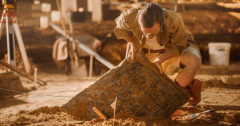We are just over eight months into the new year, and already, several significant historical discoveries have been announced. These discoveries span continents and thousands of years of history, and as we learn more about them, they continue to expand our knowledge of those who came before us. Among these are discoveries that we weren’t necessarily expecting, and these have changed how historians view past events.
On this list are just ten of these unexpected historical findings, and there is no doubt that there are many more to come.
Related: 10 WWII Discoveries Kept Secret or Hidden for Decades
10 Physical Evidence of Gladiators Fighting Wild Animals
What Animals Did Roman Gladiators Fight?
A skeleton of a young man, buried between 1,725 and 1,825 years ago in what is now York, England, has been recovered from a Roman cemetery. While the skeleton itself is nothing out of the ordinary, the bite marks on its pelvis instantly intrigued historians and archaeologists.
The remains were recovered from Driffield Terrace, which is believed to be a gladiator graveyard. The bite marks were made by a large cat, most likely a lion. Experts believe they are the first physical evidence of the Romans’ documented fights between gladiators and animals.
The marks also suggest that gladiators are buried at the cemetery, not slaves or soldiers, as once thought. In-depth analysis of the skeleton revealed that the man, aged between 26 and 35, suffered malnutrition as a child. There was also evidence of spine issues and lung inflammation. The analysis also showed that the lion bite never healed and caused the man’s death. He was decapitated after he died—possibly as a mercy killing.[1]
9 3,000-Year-Old Lost Mayan City
Maya Civilization Secrets: Lost 3,000-Year-Old City Reveals Shocking Discoveries
Archaeologists working in Guatemala’s northern jungle unearthed the ruins of a 3,000-year-old Mayan city earlier this year. The remains include monuments and pyramids, suggesting the site was once integral to ceremonial rites.
Experts date the remains to the Middle Preclassic period, from approximately 800 to 500 BC. Nicknamed Los Abuelos, after the sculptures of an “ancestral couple” found at the site, the area covers around 6 square miles.
Among the ruins is a 33-foot-high (10-meter-high) pyramid with an intricate canal system and murals dating to the Preclassic period. Archaeologists confirmed that Los Abuelos once stood 13 miles (21 km) from Uaxactun, another important historical site in the Petén department.[2]
8 2,300-Year-Old Celtic Sword
Two well-preserved swords have been discovered at a Second Iron Age Celtic burial site in France.
Excavations at a burial site in France have unearthed two Celtic swords dating to the Second Iron Age. Both swords were still inside their scabbards, which helped protect them from the elements. One of the scabbards is adorned with ornate, polished gems—and two of these gems have swastika markings on them.
Ancient swastikas are not related to anything Nazi. Instead, they were common symbols in the Mediterranean and among the Celts during the late fifth to fourth century BC.
There are no skeletons in the burial site where the swords were found, due to the high levels of acidity in the soil. However, other metal artifacts were also discovered, including decorated fibulae and copper alloy bracelets.[3]
7 Intact Roman-Era Shipwreck
Archaeologists Discover Perfectly Preserved Roman Treasure Shipwreck
Türkiye’ s Culture and Tourism Minister Mehmet Nuri Ersoy dived down into the depths of the ocean off Adrasan to personally inspect a recently discovered 2,000-year-old intact Roman-era shipwreck. The wreck lies 150 feet (46 m) below the sea surface and still contains its original cargo of ceramic plates, pots, trays, and bowls.
These ceramics were once coated in raw clay, which allowed their colors and designs to stay protected underwater. They still lie perfectly stacked in the position they were packed in, providing a stunning historical snapshot.
Archaeologists agree that the ship was transporting consumer goods when it sank and noted that it is one of more than 400 discovered in the region over the years. The latest discovery again highlights the area’s significance in maritime trade and commerce.[4]
6 Possible Location of Mahanaim
Bible Archaeology: Ancient Israelite Palace Discovered in Jordan!
In January 2025, researchers announced the discovery of a 2,700-year-old archaeological site in Jordan. They also suggested that a residence on the site may have been used by the kings of Israel, possibly including King David.
The site itself is thought to be that of the biblical city of Mahanaim, which was part of the kingdom of Israel. Mahanaim in ancient Hebrew means “two camps.” According to biblical passages, it was located beside Penuel. Researchers believe that an archaeological site called Tall adh-Dhahab esh-Sharqi is Penuel. It lies near the newly discovered site of Mahanaim, also known as Tall adh-Dhahab al-Gharbi.
The Bible also speaks of a temple in Penuel, and remains of what may have been a temple have been uncovered at Tall adh-Dhahab esh-Sharqi.[5]
5 Drag Marks Left by Ancient Vehicles
World’s first vehicle? Archaeologists uncover 22,000-year-old tracks in New Mexico
Researchers have found drag marks alongside 20,000-year-old footprints at White Sands National Park in New Mexico. After consulting with Indigenous communities, they concluded that a type of travois left the marks. These wooden vehicles—essentially wheelbarrows without wheels—would have allowed humans to transport goods by dragging them across the ground.
It is believed that dogs pulled these travois, and later, horses, during the time European colonizers entered the region. Some researchers, however, think only humans pulled the travois in New Mexico, since no animal evidence has been found near the drag marks here. The size of the footprints suggests that adults would have pulled the travois, while children followed.
This discovery proves our ancestors had some form of “transport” that allowed them to migrate long before the invention of wheels. Some of the travois tracks measure up to 165 feet (50 m) at several points throughout the park.[6]
4 Evidence of Humans on Malta
The primitive human population discovered in Malta about 8,500 years ago
The discovery of food waste, stone tools, and hearths at a cave site in Latnija has overturned researchers’ long-held belie





